1. Remove the gearbox from the car (see Removal and installation of a transmission). Clean it of dirt and wash the outside.
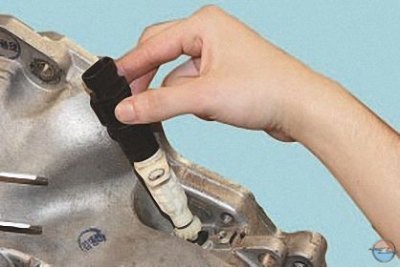
2. Remove the speedometer drive together with the vehicle speed sensor, if any (see Check and replacement of gauges of a control system of the engine).
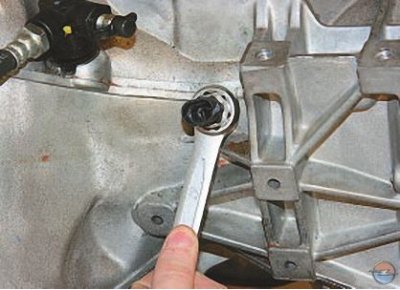
3. Loosen the reverse light switch..
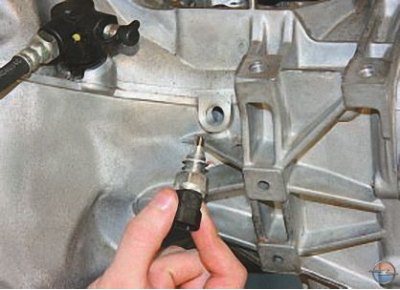
4.... and remove the switch.
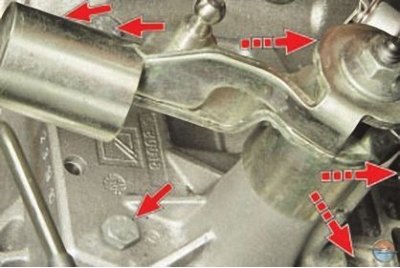
5. Having unscrewed bolts of fastening of the case of the mechanism of a gear change, remove the mechanism…
Note. The three bolts of the gearshift housing are not visible in the photo.
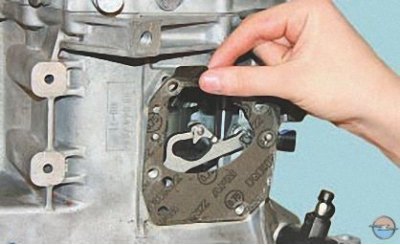
6.... and the gasket installed under it.
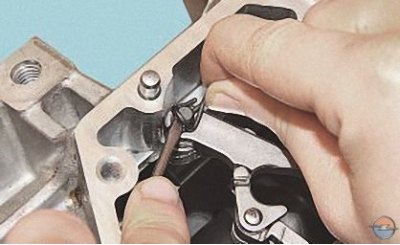
7. Prying with a screwdriver the spring retainer of the leash of the V gear engagement fork..
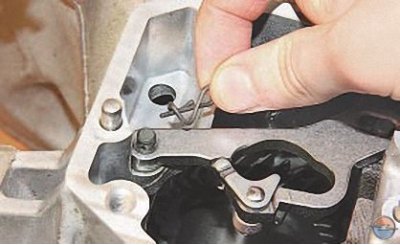
8.... remove the retainer..
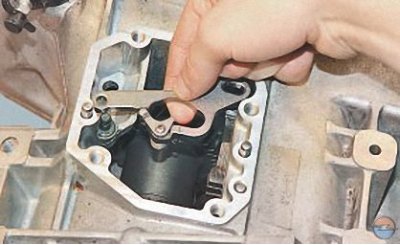
9.... and remove the leash.
10. Remove the slave cylinder of the clutch release drive assembly with the clutch release bearing (see Replacing the working cylinder of the clutch release drive with the release bearing) and a rubber o-ring installed under the cylinder.
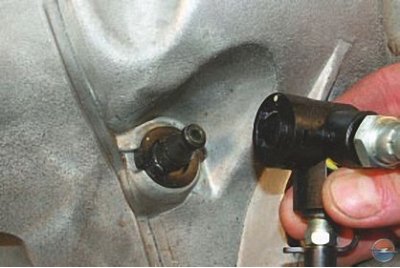
11. Remove the hydraulic clutch release adapter (see Replacement of the pipeline of a hydrodrive of deenergizing of coupling).
12. Remove the intermediate tube of the hydraulic clutch release (see Replacement of the pipeline of a hydrodrive of deenergizing of coupling).
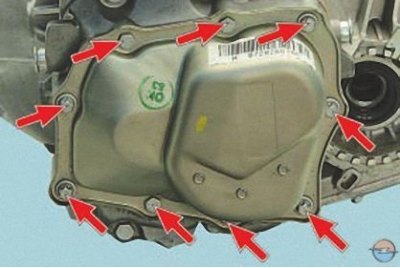
13. Turn out nine bolts of fastening of a back cover of a transmission.
14. Pry off the edge of the cover with a screwdriver in the area of \u200b\u200bthe tide specially designed for this purpose, separate the cover from the gasket and remove the cover.
15. Remove the cover gasket.
Note. Replace the gearbox rear cover gasket with a new one each time the connection is disassembled, since a used, crimped gasket may not provide a tight seal when reassembled.
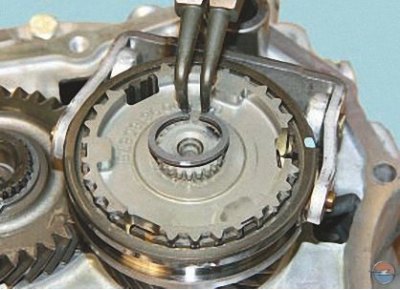
16. Remove a lock ring of the synchronizer of V transfer.
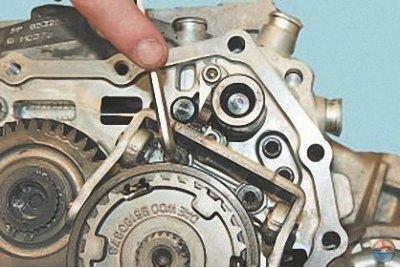
17. Turn out two bolts of fastening of an arm of a fork of inclusion of V transfer…
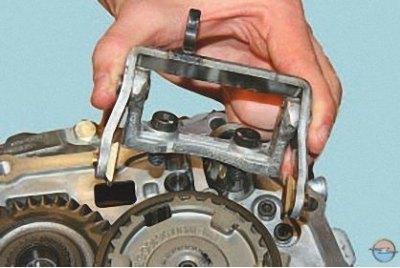
18.... and remove the bracket assembly with the fork.
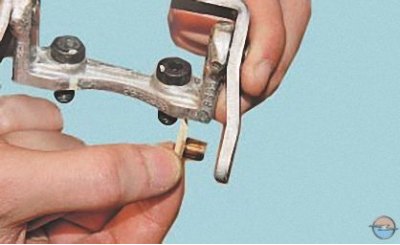
19. Remove crackers from the fork.
Note. Worn crackers during assembly, replace with new ones.

20. Install a universal puller on the V gear synchronizer clutch..
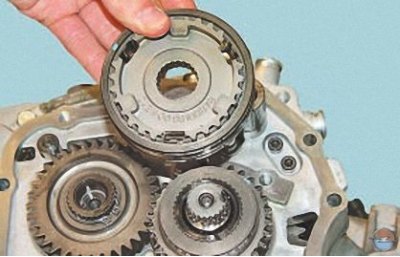
21.... and press the coupling assembly with the hub off the shaft.
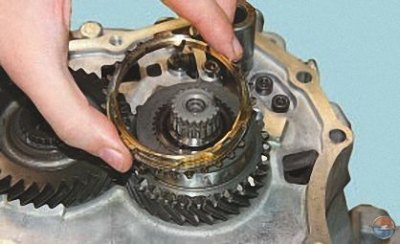
22. Remove the synchronizer blocking ring..
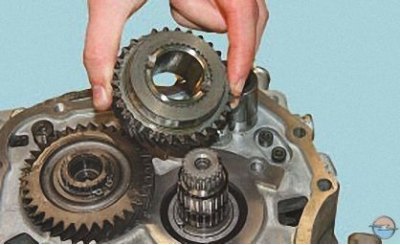
23.... the driven gear of the V transmission..
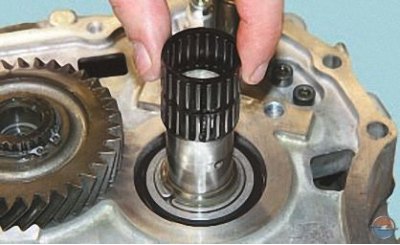
24.... and a needle bearing.
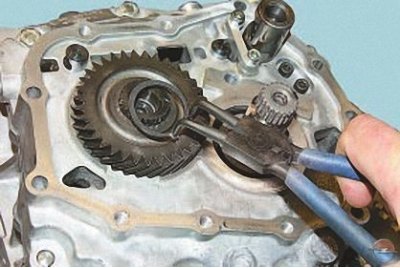
25. Remove the circlip of the 5th gear drive gear.
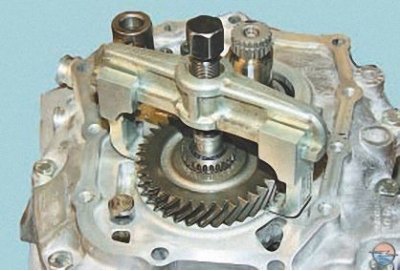
26. Install a universal puller on the 5th gear drive gear..
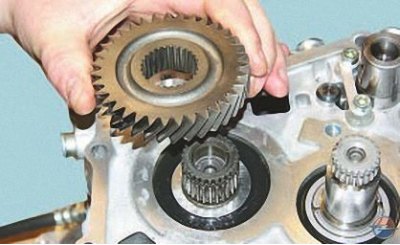
27.... and press the gear off the shaft.
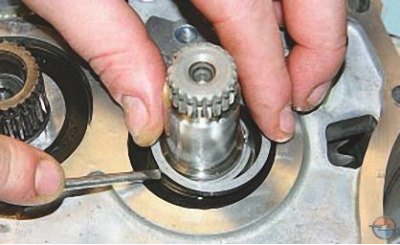
28. Remove the locking ring from the secondary shaft..

29.... and remove the two thrust half rings.
30. Remove the five bolts securing the intermediate housing to the gearbox housing..

31.... separate the intermediate crankcase from the crankcase of the box with hammer blows through a wooden spacer supported by a special tide of the crankcase..
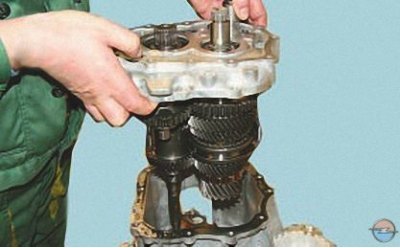
32.... and remove the intermediate housing along with the shafts.
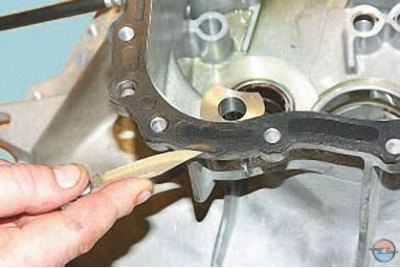
33. Remove the crankcase gasket by separating it with a sharp knife.
Note. Replace the intermediate housing gasket with a new one each time the connection is disassembled, since a used, crimped gasket, when reassembled, may not provide a tight seal.
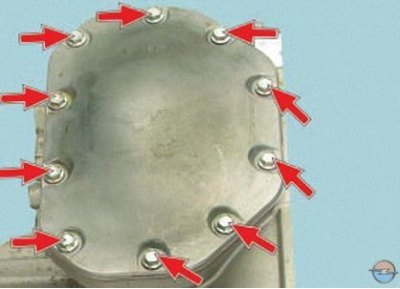
34. Turn out ten bolts of fastening of the bottom cover of a transmission and remove a cover together with a lining.
35. Separate the gasket from the cover.
Note. Replace the gearbox bottom cover gasket with a new one each time the connection is disassembled, since a used, crimped gasket may not provide a tight seal when reassembled.
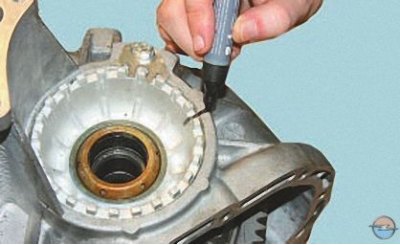
36. Mark the position of the differential bearing adjusting nut relative to the gearbox housing.

37. Turn out a bolt of a clamp of an adjusting nut …
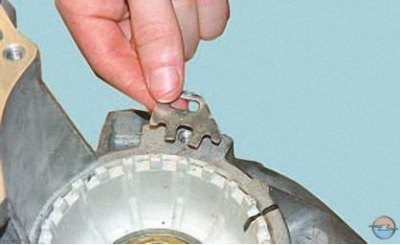
38.... remove the latch..
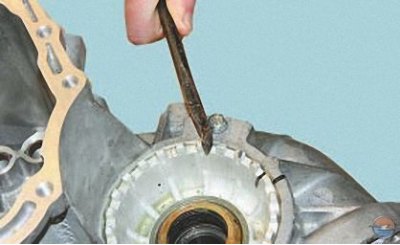
39.... remove the adjusting nut from its place with a mounting spatula, as shown in the photo..
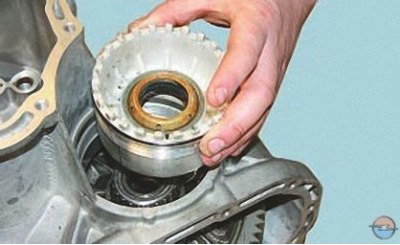
40.... and, counting the number of revolutions, unscrew the nut.
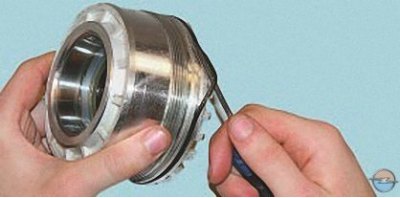
41. Remove the o-ring from the nut.
Note. Replace a severely compressed, hardened or torn ring.
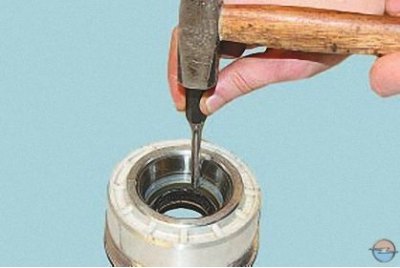
42. Press the axle shaft seal out of the nut.
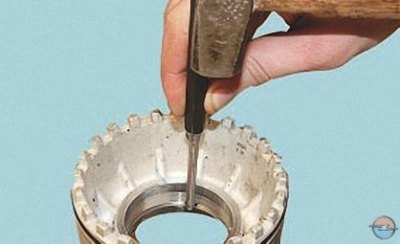
43. If it is necessary to replace the differential bearings, turn the adjusting nut over, place a pair of wooden blocks and press the outer ring of the differential bearing out of the nut.
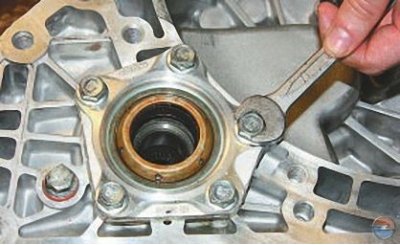
44. Turn out five bolts of fastening of a cover of the right bearing of differential..
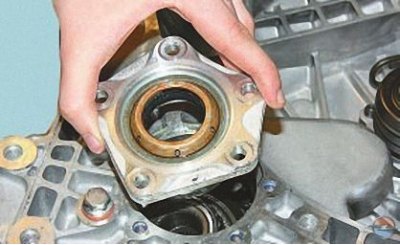
45.... remove the cover and the sealing ring from it, press the stuffing box out of the cover and, if necessary, the outer ring of the bearing in the same way as they were pressed out of the adjusting nut.
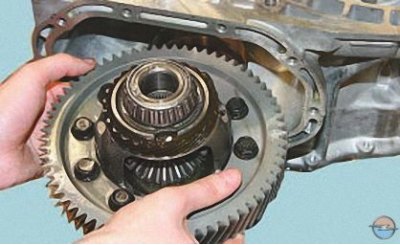
46. Remove the differential assembly from the gearbox housing.
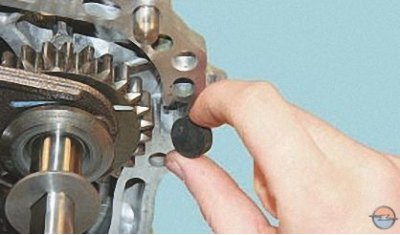
47. Remove the magnet from the crankcase..
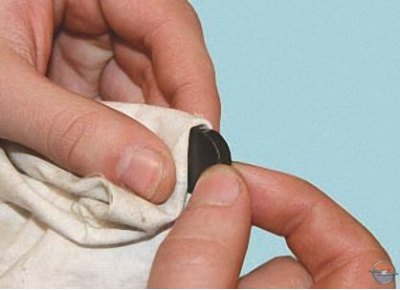
48.... and clean it of wear products.
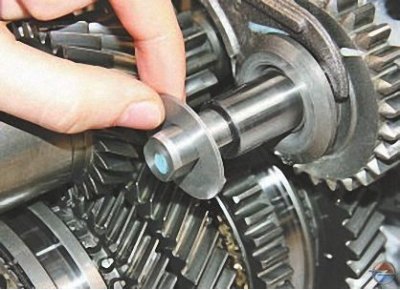
49. Remove the spacer washer from the reverse idle gear shaft.
Note. The reverse idler gear spacer may remain in the gearbox housing when the gearbox housing and intermediate housing are separated. Get her out of there.
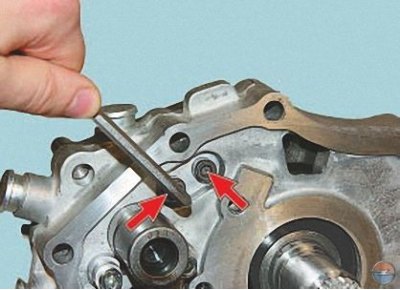
50. Turn out two bolts of fastening of an arm of a dog..

51.... install the fork rods sequentially in the position of II, V and III gears and remove the bracket assembly with the pawl.
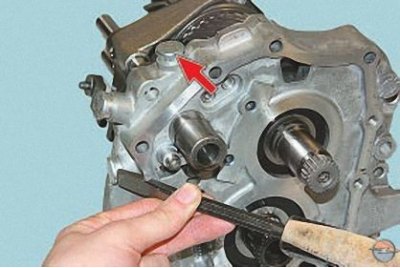
52. With a hammer through a chisel with a blunt sting, knock out the plugs of the retainers of the gear shift forks..
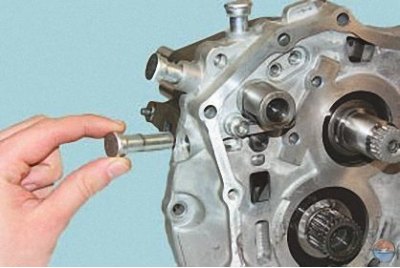
53.... and remove the retainers.
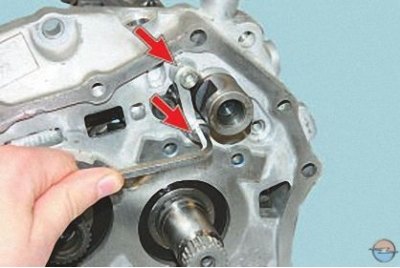
54. Remove the two screws securing the locking pin..
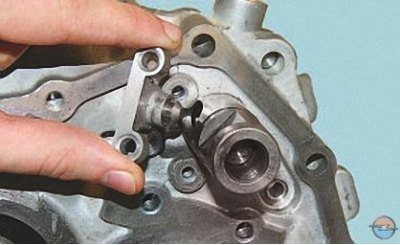
55.... remove the bracket..
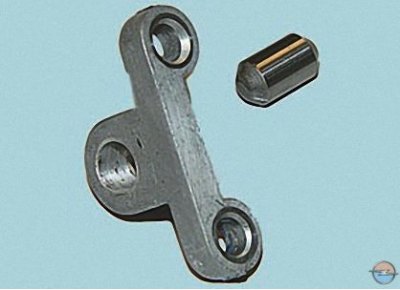
56.... and remove the pin from the bracket.
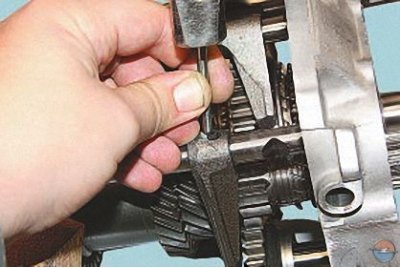
57. Leaning the free end of the rod on a wooden block, knock out the fastening pin of the fork for turning on the reverse intermediate gear with a beard..
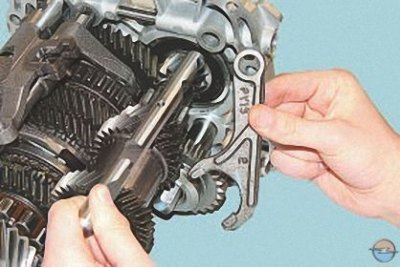
58.... and remove the stem and fork.
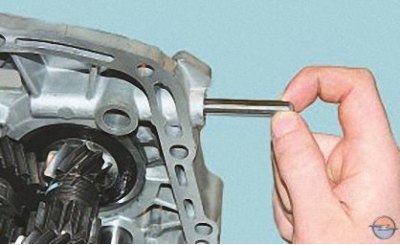
59. From the holes of the intermediate crankcase, remove the pin blocking the simultaneous inclusion of two gears.
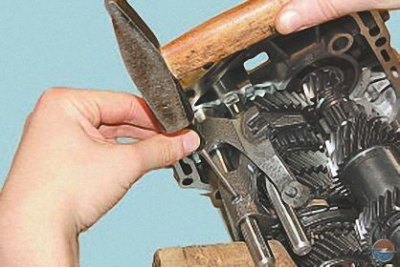
60. Knock out the pin for the shift fork of III and IV gears..

61.... remove the stem and remove the fork.
Note. The gear shift clutches must be in the neutral position when the fork is removed.
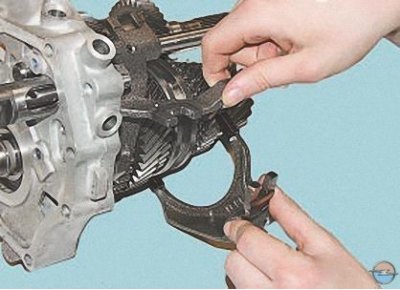
62. Raise the leash of the 5th gear fork and remove the 3rd and 4th gear fork.
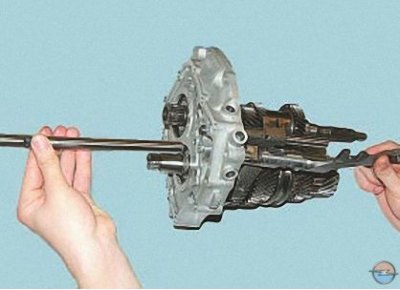
63. Remove the rod from the crankcase and remove the leash of the V gear fork.
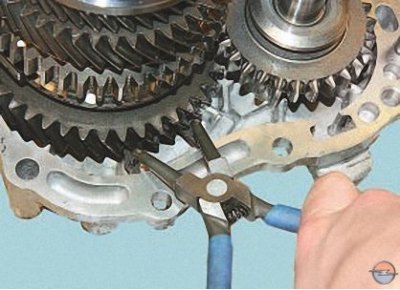
64. Puller for internal circlips (working in compression) compress the circlip of the output shaft bearing..
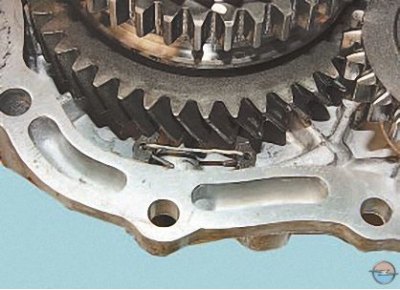
65.... and fix it in this position.
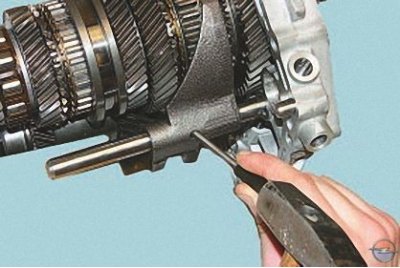
66. Knock out the pin for the shift fork of I and II gears..
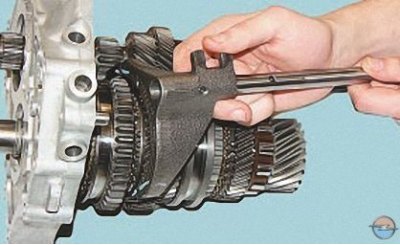
67.... remove the stem and remove the fork.

68. Puller for external circlips (working on expansion) release the circlip on the input shaft bearing..
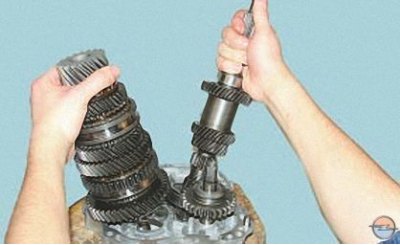
69.... and remove the primary and secondary shafts, removing their shanks from the intermediate crankcase.
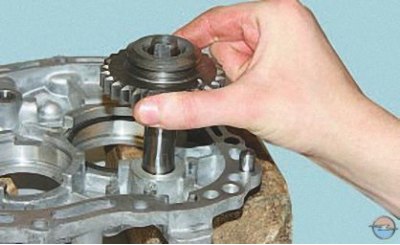
70. Remove the reverse idle gear.
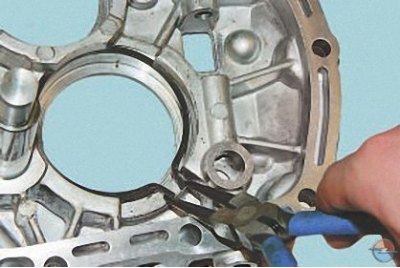
71. With a puller, remove the retaining ring of the input shaft bearing from the groove of the intermediate crankcase.
72. Before inspection and troubleshooting, thoroughly rinse and dry the gearbox parts.
73. Inspect the gearbox housing, intermediate housing and rear cover. They should not have chips. There should be no nicks, scratches, dents, etc. on the mating surfaces. Remove minor damage with fine-grained sandpaper. If severely damaged, replace defective parts.
74. Check the bearing seats. These surfaces must not show signs of wear or damage. If there is damage, replace the crankcases.
75. Check up a condition of rods of inclusion of transfers. If the stems are bent or have nicks, burrs, or hole holes for the retainers, replace the stems.
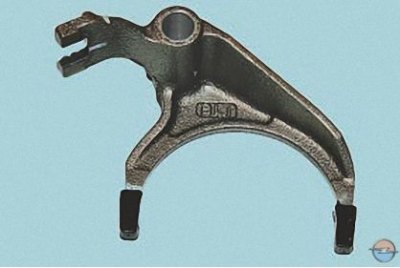
76. Check the condition of the shift forks. If they are bent or the tabs are worn, replace these parts.
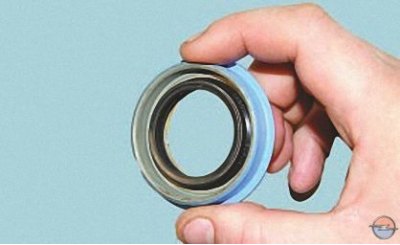
77. If oil leakage through the seals is detected during operation and if their working edges are worn, the seals must be replaced.
78. Check the condition of the bearings. If shells are found on the treadmills and rolling elements, traces of indentation of the rolling elements on the treadmills or if the cages are damaged, the bearings must be replaced.
79. Replace the gaskets of the intermediate crankcase, the rear cover of the gearbox and the gearshift mechanism.
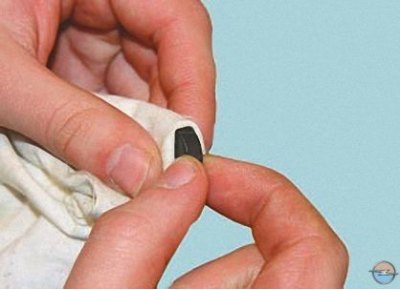
80. Clean the magnet of wear particles. If the magnet is cracked or magnetically weak, replace the magnet.
Assemble the gearbox in the reverse order of disassembly, taking into account the following.
1. Before assembly, liberally lubricate all friction parts with gear oil.
2. Assemble all threaded connections using an anaerobic threadlocker.
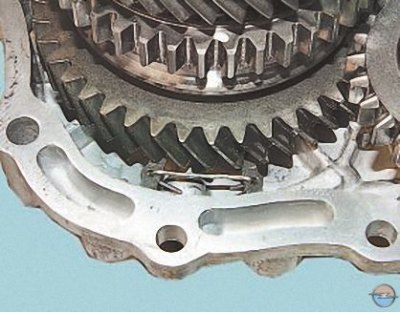
3. Before installing the output shaft in the intermediate crankcase, squeeze the retaining ring with round-nose pliers and fix it with a wire in a compressed state. Remove the wire after installing the shaft in the crankcase, making sure that the ring entered the grooves in the crankcase without distortion.
4. When installing the differential, if its bearings have not been changed, tighten the adjusting nut of its bearings by the same number of turns as when unscrewing, until the marks made during disassembly are aligned.
5. If the bearings of the differential were changed, after installing it, adjust the preload of the bearings according to the value of the moment of resistance to turning the bearings by screwing or unscrewing the adjusting nut. For new bearings, the modulus of resistance must be 2 Nm (0.2 kgf·m) when the main gear driven gear rotates at a speed of 1 rev / s. If the bearings have not been changed, then the moment of resistance should be 1 Nm (0.1 kgf·m).
6. Lubricate the gasket with grease before installing the transmission bottom cover.

Visitor comments